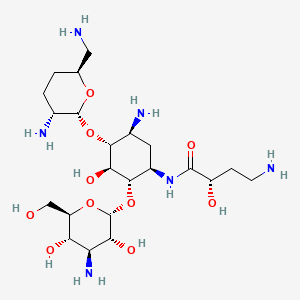



1. 1-n-((s)-4-amino-2-hydroxybutyryl)dibekacin
2. 4-amino-2-hydroxybutylyldibekacin
3. Arbekacin Sulfate
4. Habekacin
5. Me1100
1. 51025-85-5
2. Arbekacina
3. Haberacin
4. Arbekacine
5. Arbekacinum
6. Arbekacin [inn]
7. Me1100
8. G7v6sli20l
9. Chebi:37922
10. Arbekacin (inn)
11. 51025-85-5 (free Base)
12. (2s)-4-amino-n-[(1r,2s,3s,4r,5s)-5-amino-4-[(2r,3r,6s)-3-amino-6-(aminomethyl)oxan-2-yl]oxy-2-[(2s,3r,4s,5s,6r)-4-amino-3,5-dihydroxy-6-(hydroxymethyl)oxan-2-yl]oxy-3-hydroxycyclohexyl]-2-hydroxybutanamide
13. Me-1100
14. Arbekacine [french]
15. Arbekacinum [latin]
16. Arbekacin Sulfate [jan]
17. Arbekacina [spanish]
18. Npc-14
19. (s)-4-amino-n-((1r,2s,3s,4r,5s)-5-amino-2-(((2s,3r,4s,5s,6r)-4-amino-3,5-dihydroxy-6-(hydroxymethyl)tetrahydro-2h-pyran-2-yl)oxy)-4-(((2r,3r,6s)-3-amino-6-(aminomethyl)tetrahydro-2h-pyran-2-yl)oxy)-3-hydroxycyclohexyl)-2-hydroxybutanamide
20. Ncgc00167530-01
21. Unii-g7v6sli20l
22. Dkb-ahb
23. Arbekacin [mi]
24. Arbekacin [who-dd]
25. Schembl18413
26. Chembl426926
27. Gtpl7345
28. Dtxsid8048319
29. Zinc9575047
30. Akos025149466
31. Db06696
32. D-streptamine, O-3-amino-3-deoxy-alpha-d-glucopyranosyl-(1-6)-o-(2,6-diamino-2,3,4,6-tetradeoxy-alpha-d-erythro-hexopyranosyl-(1-4))-n(sup 1)-(4-amino-2-hydroxy-1-oxobutyl)-2-deoxy-, (s)-
33. D-streptamine, O-3-amino-3-deoxy-alpha-d-glucopyranosyl-(1-6)-o-(2,6-diamino-2,3,4,6-tetradeoxy-alpha-d-erythro-hexopyranosyl-(1-4))-n1-(4-amino-2-hydroxy-1-oxobutyl)-2-deoxy-, (s)-
34. O-3-amino-3-deoxy-alpha-d-glucopyranosyl-(1->4)-o-(2,6-diamino-2,3,4,6-tetradeoxy-alpha-d-erythro-hexopyranosyl-(1->6))-n'-((2s)-4-amino-2-hydroxybutyryl)-2-deoxy-l-streptamine
35. O-3-amino-3-deoxy-alpha-d-glucopyranosyl-(1-4)-o-(2,6-diamino-2,3,4,6-tetradeoxy-alpha-d-erythro-hexopyranosyl-(1-6))-n'-((2s)-4-amino-2-hydroxybutyryl)-2-deoxy-l-streptamine
36. D07462
37. 025a855
38. Q4784668
39. (2s)-4-amino-n-[(1r,2s,3s,4r,5s)-5-amino-2-(3-amino-3-deoxy-alpha-d-glucopyranosyloxy)-4-(2,6-diamino-2,3,4,6-tetradeoxy-alpha-d-erythro-hexopyranosyloxy)-3-hydroxycyclohexyl]-2-hydroxybutanamide
40. (2s)-4-amino-n-[(1r,2s,3s,4r,5s)-5-amino-2-{[(2s,3r,4s,5s,6r)-4-amino-3,5-dihydroxy-6-(hydroxymethyl)oxan-2-yl]oxy}-4-{[(2r,3r,6s)-3-amino-6-(aminomethyl)oxan-2-yl]oxy}-3-hydroxycyclohexyl]-2-hydroxybutanamide
41. (2s)-4-amino-n-[(1r,2s,3s,4r,5s)-5-amino-4-[(2r,3r,6s)-3-amino-6-(aminomethyl)tetrahydropyran-2-yl]oxy-2-[(2s,3r,4s,5s,6r)-4-amino-3,5-dihydroxy-6-(hydroxymethyl)tetrahydropyran-2-yl]oxy-3-hydroxy-cyclohexyl]-2-hydroxy-butanamide
42. (2s)-4-amino-n-{(1r,2s,3s,4r,5s)-5-amino-2-[(3-amino-3-deoxy-alpha-d-glucopyranosyl)oxy]-4-[(2,6-diamino-2,3,4,6-tetradeoxy-alpha-d-erythro-hexopyranosyl)oxy]-3-hydroxycyclohexyl}-2-hydroxybutanamide
43. (s)-4-amino-n-((1r,2s,3s,4r,5s)-5-amino-2-((2s,3r,4s,5s,6r)-4-amino-3,5-dihydroxy-6-(hydroxymethyl)tetrahydro-2h-pyran-2-yloxy)-4-((2r,3r,6s)-3-amino-6-(aminomethyl)tetrahydro-2h-pyran-2-yloxy)-3-hydroxycyclohexyl)-2-hydroxybutanamide
44. 84g
45. Butanamide, 4-amino-n-[(1r,2s,3s,4r,5s)-5-amino-2-[(3-amino-3-deoxy-.alpha.-d-glucopyranosyl)oxy]-4-[(2,6-diamino-2,3,4,6-tetradeoxy-.alpha.-d-erythro-hexopyranosyl)oxy]-3-hydroxycyclohexyl]-2-hydroxy-, (2s)-
46. D-streptamine, O-3-amino-3-deoxy-.alpha.-d-glucopyranosyl-(1->6)-o-(2,6-diamino-2,3,4,6-tetradeoxy-.alpha.-d-erythro-hexopyranosyl-(1->4))-n1-((2s)-4-amino-2-hydroxy-1-oxobutyl)-2-deoxy-
47. O-3-amino-3-deoxy-.alpha.-d-glucopyranosyl-(1->4)-o-(2,6-diamino-2,3,4,6-tetradeoxy-.alpha.-d-erythro-hexopyranosyl-(1->6))-n'-((2s)-4-amino-2-hydroxybutyryl)-2-deoxy-l-streptamine
| Molecular Weight | 552.6 g/mol |
|---|---|
| Molecular Formula | C22H44N6O10 |
| XLogP3 | -6.8 |
| Hydrogen Bond Donor Count | 11 |
| Hydrogen Bond Acceptor Count | 15 |
| Rotatable Bond Count | 10 |
| Exact Mass | 552.31189162 g/mol |
| Monoisotopic Mass | 552.31189162 g/mol |
| Topological Polar Surface Area | 297 Ų |
| Heavy Atom Count | 38 |
| Formal Charge | 0 |
| Complexity | 757 |
| Isotope Atom Count | 0 |
| Defined Atom Stereocenter Count | 14 |
| Undefined Atom Stereocenter Count | 0 |
| Defined Bond Stereocenter Count | 0 |
| Undefined Bond Stereocenter Count | 0 |
| Covalently Bonded Unit Count | 1 |
Arbekacin is used for the short term treatment of multi-resistant bacterial infections, such as methicillin-resistant Staphylococcus aureus (MRSA).
Arbekacin is an aminoglycoside. Aminoglycosides function by binding to bacterial 30S ribosomal subunits, causing t-RNA misreads, and preventing the production of proteins. Anaerobes are less susceptible to aminoglycosides because they do not spend as much energy as aerobes on taking up chemicals like aminoglycosides. Aminoglycosides are useful primarily in infections involving aerobic, gram-negative bacteria, such as Pseudomonas, Acinetobacter, and Enterobacter.
Anti-Bacterial Agents
Substances that inhibit the growth or reproduction of BACTERIA. (See all compounds classified as Anti-Bacterial Agents.)
J - Antiinfectives for systemic use
J01 - Antibacterials for systemic use
J01G - Aminoglycoside antibacterials
J01GB - Other aminoglycosides
J01GB12 - Arbekacin
Absorption
Aminoglycosides are not well absorbed from the gastrointestinal tract. Their absorption is markedly improved by parenteral administration.
3 hours
Arbekacin irreversibly binds bacterial 30S and 16S ribosomal subunits inhibiting protein synthesis. Arbekacin binds to 4 nucleotides of the 16S subunit and 1 amino acid of protein S12 to interfere with the decoding site around nucleotide 1400 in the 16S subunit. Interference with the decoding site interferes with its interaction with the wobble base of tRNA. This hindered interaction causes mRNA to be misread and the incorrect amino acids are inserted into protein. These error filled proteins are not able to function or may even be toxic.